Bees value their secrecy. We, as beekeepers, violate it out of love because we want to know how best to care for them.
It is possible to learn a few things about the colony by observing the entrance and watching the bees go in with pollen and nectar. But there is a lot more behind those four walls that remain unseen.
Opening the hive can be unnecessarily intrusive. You risk chilling your bees in the winter or exposing them to robbing during a nectar dearth.
It would be helpful if you knew that your intervention was really needed before ripping the roof off their heads.
A beehive scale is just the tool you need to get that insight.

What is a Beehive Scale?
A bee hive scale is a measuring device that will provide considerable information to tell you if there is a need for an intrusive investigation.
Whether you are new to beekeeping or have years of experience, the more information you can get about your bees, the better.
Bee colonies in the same apiary will differ in behavior and productivity. It is not a good idea to assume that if one has enough stores for the winter, the others do, too.
This article will show why you need to weigh your beehives and what beehive scales you will find in the market.
Why Do We Weigh Hives?
There are a few reasons why beekeepers keep weighing their hives.
Monitoring and data collection
The best information helps you make predictions in the future, which requires time to collect. For example, information about the beginning and end of nectar flows and swarming seasons enables a beekeeper to plan their activities in good time.
Knowing your hive’s weight would also provide you with data on the number of bees you have in a hive. In beekeeping, weighing a hive is just one way to get an estimate of your honey harvest for that season.
Weight scales and devices could also prevent swarming. If you split your colonies too late, you may lose a swarm. Not knowing when the nectar flow begins in the spring could lead you to starve your bees. This happens more often than you think. In many cases, when a beekeeper finds a dead out that starved, the colony probably made it past the dead of winter, only to run out of food just before the flowers bloomed.
The best way to collect this kind of information is to have a set-up that allows daily monitoring and keeping track of the increase and decrease of the hive’s weight. It will be interesting to see how productivity in your area differs from one year to the next.

Winter Preparation
When the temperature drops and the snow coats everything in sight, you want to know that your bees have everything they need indoors.
During the winter, not only will it be a bad idea to open the hive and let the warmth out, but you might not even be able to get to them as often as you like.
As fall changes to winter, it is vital to find out if the bees collected enough nectar to get them through spring. You will need to weigh each hive individually to determine that they have enough stores for the winter.
The honey requirements will differ depending on where you are in the country. It is best to visit your local beekeeping association to find out what works best in your zone, but we can provide a few examples:
Florida
- 80 lbs for winter
Illinois
- 90 lbs (1 full deep or two mediums)
Bedfordshire (U.K.)
- 40 lbs
Michigan
- 70-100 lbs (1 deep super + 3-4 deep frames or 2 medium supers + 2-3 medium frames)
These numbers do not include the weight of the hive and the bees, meaning the total weight may be around 300 pounds.
The honey requirement will also depend on the colony’s size and subspecies. For example, Italian bees are well known for their heavy consumption.
For this reason, there is real value in the daily monitoring of at least one hive in your apiary all year round. By adding notes periodically on the hive’s internal state alongside the weight fluctuations, you will be able to build a clearer picture and determine the needs of a colony.
You can apply the same data to your other bee hives, enabling you to make better overwintering decisions. Perhaps a smaller colony needs fewer hive boxes or should be combined with another colony for the numbers.
What Information Do You Get from a Beehive Scale?
The Beginning and End of Nectar Flow

Setting up your hive just as spring begins will enable you to see how much nectar is coming into the beehive and how long the steady increase continues.
There may be days that the weight stagnates or slightly dips during the nectar flows, signaling slowed foraging activity due to factors such as the weather. Usually, those little ladies will be active until there is nothing more to get from the trees and flowers around them.
The exact measures may not be too exact in the first year. However, the information will probably be more precise in the second year because you get to determine when the switch changes to the hour based on your monitoring system.
You can also tell when it is time to add a new super and predict how much honey to expect at the end of the season.
Peak Foraging Conditions
You must provide context for your weight readings, which is why some of the more technological solutions will include temperature sensors and thermal cameras. But, if you don’t have these devices yet, a quick note on the day’s weather will basically explain irregular patterns in your readings.
If you want to harvest single-crop honey, noting the highest weight increase days and when it starts to taper off will help you harvest and market your honey for its maximum value.
On a grander scale, the data you collect through these hive scales and devices can be collated and used to inform studies and policies in your area.
Swarming Activity

Losing a swarm would cost you both honey and time. In addition, a homeless swarm of bees can be a nuisance to neighbors.
Preventing a natural split is often a priority for beekeepers. But, unfortunately, sometimes bees go off script and swarm anyway.
If you are in the area, you might be able to save and recapture them. It takes some experience to identify which one of your hives is likely to swarm.
In addition to inspecting your hives for swarm cells and overcrowding, monitoring the daily weight may help you identify when a swarm has left the beehive. You are likely to be away when they do.
You can also learn when best to attract and trap a swarm. Instead of relying on package bees, which may dent your pocket, why not benefit from what nature offers freely?
Knowing the swarming season will ensure that you set up your bait hives in time to restock your apiary.
Rate of Honey Consumption during Nectar Dearths
One of the mistakes beekeepers make is harvesting too much honey. It depletes the colony of the necessary reserves to get them through when little to no nectar is available.
Once the nectar stops coming in, you will notice a steady decline in the hive’s weight. Monitoring this weight reduction will alert you when you need to intervene and feed your bees.
What Features to Look Out for in a Beehive Scale
Durability
A beehive scale is portable and used outdoors, moved from one hive to another. Your typical glass-topped bathroom scale or luggage scale will not work here.
A good hive scale should be durable enough to survive some manhandling and should not break easily during weighing.
Weather Resistance
If you are using the hive scale for full-time monitoring, it should withstand the weather through all the seasons.
Your chosen beehive scale should encase the mechanism to keep it safe from moisture, humidity, and high temperature.

Accuracy
Work with a beehive scale that offers the smallest margin of error.
Depending on the hive scale you’re using, you may need to calculate your final result to get the measurements and come up with an accurate reading.
Pay attention to the technique you use in the course of weighing your beehive, such as tilting, to minimize your conversion error.
Maximum Capacity
A beehive ready for winter can weigh over 300 pounds. Choose a hive scale that can handle a hive weight of at least 500 pounds with a low margin of error.
Top Picks for Beehive Scales
DIY Options
Pry Scale
If your budget only has room for a low-tech option, you can assemble a beehive scale yourself. Fortunately, bee enthusiasts had gone before you and created solutions just like a pry scale.
The premise is that by prying one side of the scale off the bottom board, you will use half the force it would take to pry the whole hive. Take your reading, multiply it by two, and get your final measurement of the hive weight.
You can read more about the Pry scale and how to make it here.
Bee Weigh
The Bee Weigh scale works by using the force required to lift the hive just enough to get a reading.
The challenge of finding a weighing scale that can withstand the elements for a long time is eliminated. The scale is foldable, portable, and relatively inexpensive to build.
You can read more about how it works and how to put it together here.
Other Beehive Scale Options
Here’s an example of a beekeeper who made his own beehive scale. The final measurement requires a little math, but maybe that will work for you.

Commercial Options
Broodminder
When life gets in the way of your bee monitoring, it helps to have a device that does everything and sends you information wherever you are.
The Broodminder hive scale is small and sits just under the hive above the stand. Yet, it does not cover the bottom board, so your screen bottom board can still do its job.
The battery will keep the scale running for six months, and you will be contributing to an informative pool of bee-tracking data.
Hivetronics
This portable beehive scale is relatively light in weight, under 11 lbs. It is designed to weigh hives quickly and with as little disruption as possible. This tool is ideal if you have several beehives to get through in a short amount of time.
It is a little pricey, but it is easy to use and accurate. That will come in handy.
Solution Bee Smart Hive Monitor
With a capacity of 330 pounds, the Smart Hive Monitor gives accurate weight and ambient temperature readings. It then sends the data to a compatible mobile phone with Near Field Communication) connectivity.
The hive sits on the hive scale, increasing the accuracy of the measurements.
The smart hive monitor works best on individual hives rather than weighing all the hives in the apiary.
Scale up Your Information with Hive Scales
Aside from our fascination with bees, the other reason we open up hives is to get the information we would not get by lurking by their entrance.
As well-intended as this is, it is very intrusive. Where possible, we need to keep that to a minimum.
Investing in a quality beehive scale helps you keep an eye on your bees and only interfere when needed.
Do you have a beehive scale among your apiary supplies? Would you like to share any insight from your readings? Leave a comment below. We would love to hear from you!
